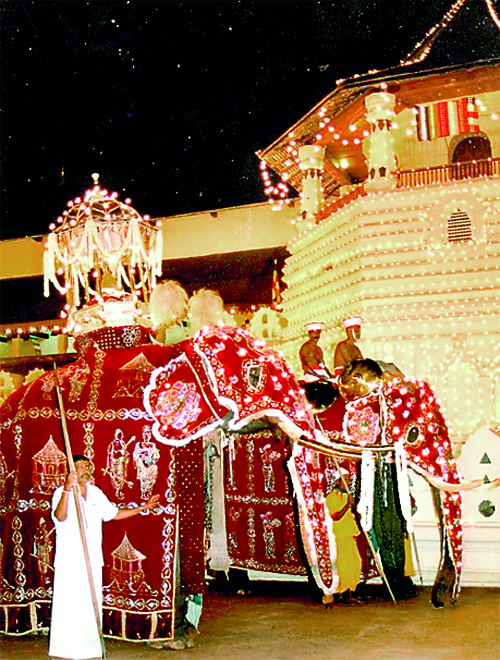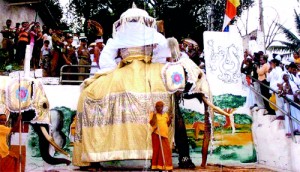Sunday Times 2
Farewell Raja
My relationship with Wewaladeniye Raja began with the election of the 19th Diyawadana Nilame Pradeep Nilanga Dela to the high office at the Sri Dalada Maligawa. I was summoned to assist him in the perahera in August that year. Raja was in a very bad state then. He had lost weight, his bones were showing and his eyes, half closed and tearing showed that he was in a weak and unhealthy condition.
With the enthusiasm of the new young Diyawadana Nilame, the perahera was conducted with over a hundred elephants that year. With his natural love for elephants he realised the value of this magnificent tusker, the need to bring him back to health and possibly use him for the noble duty of carrying the sacred perehera karanduwa in the years to come. He discussed Raja’s condition with his owner the

Raja with the writer in 2008
most Ven. Hemmathagama Sri Siddhartha Nayake Thero and sent the tusker for treatment to the Millennium Elephant Foundation in Kegalle.
Having a long association with elephants, their owners and an inborn interest in elephants, I joined the MEF as its Resident Project Manager. It was a dream come true -working with elephants full time. This organisation is also a home for retired elephants. Raja found Dayarathna as his mahout at MEF in Kegalle. Fondly referred to as Puwakdeniye aiya by all of us, he was an experienced mahout having looked after some famous elephants in his time. Raja and he got on very well, developing a close bond. I watched Raja every day along with Puwakdeniye aiya. Day by day we became close and eventually Raja developed a trust in me.
By 2007 Raja was fit enough to return to the world famous Kandy Esala Perehera.
It was in 2008 that I had a memorable experience with Raja during the Kandy perahera.
Raja stood tall below the steps of the (Watha Bandina Pola), draped in his red velvet costume worked in gold and silver, the lotus flower design giving him a majestic look. His head held high and ears alert to the beating of the drums (hewisi pooja) Raja stood still with his trunk resting upon the evenly proportioned ivory. He was waiting for the rituals to be performed. The golden casket (perahera Karanduwa) would be placed soon on the silver and gold worked palanquin (ransivige) resting upon his back. Through long years of experience Raja knew his duty too well. As soon as these rituals were over the Diyawadana Nilame would place the sacred casket on Raja. He would then bless and release Raja to parade the streets. He himself would officiate by walking behind Raja in his

His last Perehara: Raja in 2009
traditional Royal outfit accompanied by the ten Vidanes and his royal guards (Hewayo), with hundreds of Ves dancers and drummers escorting them. The crowds gathered on the streets of Kandy would stand to receive them.
Raja had performed this task for over two decades. It is no easy task, even for a tusker to perform this task continuously for the perahera’s ten-day duration. Raja had done so, in 2003 if my memory is right. Raja having no deputy to assist him carried on this noble task for the full period and also during the day perahera.
On this particular night Raja walked through the main Wahalkada and stepped on the moonstone (sandagala) exactly at the auspicious time. The sandagala becomes a place of many rituals and customs on a perahera night. As per our duties the Kariya Karawana Korale and I garlanded the Diyawadana Nilame with the traditional jasmine flowers and informed him that the perehera is ready with all due honours and decorations.
I received an urgent message from Puwakdeniye aiya summoning me to the floor below the Pathirippuwa where Raja stood with the other tuskers-Indi Raja on his left and Gamini (Botale Atha) on the right. Puwakdeniye was suffering from stomach indigestion and left me in charge of the tusker. I had a friendship with Raja but if I believed myself to be as capable as a professional mahout it would have been my imagination running riot. I had no choice though. I was chanting my prayers for the mahout’s return as soon as possible. Suddenly I realised the Maligawa perehera had passed by and it was time for us to step forward. My only hope was Kahabiliyawala Nilame, the caretaker of Botale atha and a very experienced man in the trade. He said ‘api yan …baya wenna epa’. Raja marched forward along with the other elephants and joined the perahera from below the pathirippuwa. The perahera proceeded gloriously along the Dalada Veediya and Raja seemed unconcerned.
Then we approached the Queen’s Hotel junction. Usually the perahera is delayed there as the dancers and drummers choose this place as a platform to perform. Raja stretched his legs to the front, raised his head and hissed through his trunk which gave me the jitters. Then I saw Puwakdeniye aiya walking towards us and that saved me from a possible heart attack that night. I learned later that it was Raja’s way of tightening the ropes assuring him of the safety of the Ransivige on his back. I walked with Raja right through the perahera and his discipline was par excellence.
After the death of the famous Maligawa Raja in 1988 many tuskers were tested. Saman Raja, Ruwan Raja from Ratnapura and Ruwawella and Indi Raja from the Maligawa stables. Heiyantuduwe Raja served the longest period but by the millennium, they were too old or worn out. Wewaladeniye Raja became one of the four tuskers to be able to perform the duty of bearing the sacred casket.
In 2013 Raja showed signs of ill health again. The Diyawadana Nilame brought Raja to the Maligawa stables at Pallekelle and he received the best medical attention available. But all good things come to an end. Raja passed away on the night of February 10, 2014. He was 45 years old and in his prime. The loss of Raja is irreparable to all of us involved with the Buddhist rituals and our culture. To replace such a magnificent tusker is not possible in today’s circumstances.
It is of great concern especially to the Diyawadana Nilame as how we will manage this problem of finding tuskers to perform this most important part in the perahera, carrying the Sacred Relic casket. Nadungamuwe Raja is over 65, Wasana from Kataragama cannot come when the two peraheras falling on even dates, we are left with Indi Raja. We need two or more tuskers for this historical pageant to go on.
Good bye sweet prince
You were the glory of many eyes
The pride of our great spectacle
The centre of attraction
May this be your last life as a beast
though in fame even then.
May you be born again to humanity…
In dedication to the serve the Lord Buddha……………..

